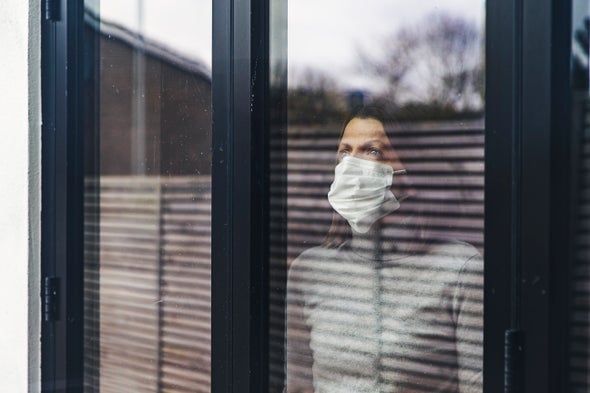Cave Syndrome: Shifting Mindsets with Facts, Credibility and Emotion

Easing of restrictions is welcomed news for arts, culture and heritage spaces. But will cave syndrome put a halt to audiences returning? We’ve got the top three things you need to do to change behaviours and help audiences feel comfortable about returning.Your blog post content here…
Lots has changed over this last year. We’ve all had to adjust our behaviours: from mask wearing, remote working and social distancing and so much more. But as difficult as the last year has been, the vaccine has provided a ray of hope that normality would return - albeit slowly.
And it has. In Ireland and the UK there are paths in place for reopening (though these are subject to change) that seems clear and - hallelujah - with tentative dates. And I know we’ve been down this road before - but we didn’t have the vaccine then and now we do, so it certainly seems like this time it will stick.
Our Resilience summit also gave some comfort (and great tips, ideas and inspiration) on reopening and planning. But one data point in particular that stuck with me was that vaccinated people are not as confident about returning to cultural spaces even after they have been fully vaccinated. In a way this makes sense of course, the studies were conducted with the first cohort to be vaccinated - the older and more vulnerable population. It is completely understandable that they might be wary of returning to normality when the statistics have shown their age group to be the most at risk.
But what about younger age groups? The data shows that they are certainly more likely to return. But if the last year has taught us anything - it is to expect the unexpected. Anxiety about a return to normal is a real issue - and there is even a name for it: Cave Syndrome.
After a year in isolation, many people who have developed an intimate understanding of what it means to socially isolate are afraid to return to their former lives despite being fully vaccinated. There is even a name for their experience: the clinical sounding “cave syndrome.”

Emerging into the light after a year locked inside is proving to be a difficult transition for some people.
Pandemic related changes have caused a lot of fear and anxiety in people about returning to in-person activities. But there are some three concrete ways you can help your audiences help shift mindsets and feel comfortable about returning.
First, it is important to note that shifting behaviours and mindsets is a complex area - long studied by psychologists. But there are some great practical tips and ideas you can use to help your audiences feel comfortable about returning. The three key areas are Facts+Credibility+Emotion.
Facts
.jpeg?width=567&name=download%20(3).jpeg)
The first and most important area to hit on when thinking about shifting mindsets are the facts. Without facts, it is impossible for your audiences to make a decision about returning. What this means for your arts organisation is:
- Clearly outline the changes you have made to your theatre or cultural space. This means any physical changes (filer systems, fogging systems, hand sanitiser stations etc.) as well as any behaviour changes of staff (mask wearing, perspex dividers etc.
- Clearly outline any changes that are to be expected of audiences. For example, if there will be one way systems in place or only sit down food and drink service.
- Use direct, simple language about these changes. Be sure these changes are easy to find on your website or as part of your marketing emails.
- Explain clearly why these measures have been put in place.
- Use all your marketing channels to communicate these changes so people know what to expect. Short explainer videos are a great tool to get these messages across in a friendly way.
- Once people do book, take advantage of Ticketsolve’s automated email workflows to send a follow up email to bookers with all of these facts and changes.
Facts and information are vitally important to help audiences understand what to expect when they return. No doubt you have likely been communicating covid related changes to your patrons already. But persuading people that it is safe to return takes more than just facts. They need to hear it from a credible source.
Credibility
.jpeg?width=623&name=download%20(4).jpeg)
When it comes to shifting behaviours, a credible communicator is critical. People need to feel that the person communicating the message is a credible and trustworthy source. There are a few key criteria for a credible source:
- The person communicating is like me.
- They are knowledgeable about the subject.
- How they present the message or information.
- They are not just focused on the positives, they truthfully explain any downsides.
So what does this mean practically when it comes to messaging around returning?
- Segment your audiences so that you can create messages that are very targeted.
- Use your brand’s authentic voice. Corporate speak is fine in some instances, but in this case it is good to connect with your audiences in a way that helps them see you as part of their community and like them.
- Use their name in any email communications. If you use Ticketsolve you’ll be able to do this easily.
- Be honest about potential problems. With all the planning in the world, things may go pear shaped when you reopen. Explaining clearly what measures you organisation has taken to protect audiences and staff is important, but be sure to also communicate to patrons that you will take any learnings from reopening and improve the experience for them. Welcome feedback.
- Note the sources you used to create the changes. Linking or explaining that your measures are a direct result of government guidelines is a good way to gain credibility.
- Other ways of demonstrating credibility is to show that your organisation isn’t alone. Check in with nearby theatres to see what measures they are putting in place. The Arts Working Group, Arts Council England, etc. are other great credible sources that can be noted in communications.
What’s good is that most people will already see your organisation as credible, so just a few tweaks to your messaging will help. The last piece of the puzzle is emotion.
Emotion

Facts plus credibility will get you incredibly far when it comes to shifting attitudes. But emotion is the key piece here. Emotion is what can really engage and get people thinking differently. The best way to engage your audiences on an emotional level? Stories.
According to the Narrative Paradigm (W. Fisher 1987), humans are “homo narrans”—storytelling animals who are persuaded to make decisions based on the coherence and fidelity of stories. Their effectiveness as a form of communication seems to be related to how the human brain processes, imposes structure on, and interprets, information.
What does this mean for helping arts, culture and heritage audiences return?
- Share your stories. Share stories from your staff, actors etc. from the last year. Funny, uplifting - any stories that help connect audiences with you.
- Have videos? Use them! Share videos or clips from previous shows with full audiences. There are some great easy to use video editing software (like Canva) you can use to create short clips for social media. These are great ways to remind audiences why they love the arts.
- Don’t be afraid to use emotional language in communications. You audiences are on your side - that is one of the benefits of working in the arts! Especially now as reopening approaches, using more emotional language can help you connect and entice your audiences back.
Are these ideas foolproof? No, but they may help some people feel more comfortable about returning to arts, culture and heritage spaces.
Cave syndrome falls on a spectrum with some people feeling incredibly anxious and others very little. If you or someone you know is experiencing heightened levels of anxiety, fear or social isolation below are some links to support services that can help.
Ireland
HSE
Aware
Samaritans
Northern Ireland
NI Direct
Aware
Samaritans
England
NHS
Time to Change
Sane
Samaritans
Wales
Wales Gov
Time to Change Wales
Samaritans
Scotland
NHS
Breathing Space
Support Mind
Think Positive
Samaritans
Categories
Recent posts
Archive
- December 2025 (2)
- November 2025 (1)
- October 2025 (3)
- September 2025 (1)
- August 2025 (3)
- July 2025 (3)
- June 2025 (3)
- May 2025 (4)
- April 2025 (5)
- March 2025 (5)
- February 2025 (4)
- January 2025 (4)
- December 2024 (3)
- November 2024 (5)
- October 2024 (4)
- September 2024 (7)
- August 2024 (5)
- July 2024 (3)
- June 2024 (3)
- May 2024 (3)
- April 2024 (3)
- March 2024 (4)
- February 2024 (5)
- January 2024 (3)
- December 2023 (3)
- November 2023 (4)
- October 2023 (4)
- September 2023 (5)
- August 2023 (3)
- July 2023 (4)
- June 2023 (4)
- May 2023 (5)
- April 2023 (4)
- March 2023 (4)
- February 2023 (5)
- January 2023 (4)
- December 2022 (4)
- November 2022 (3)
- October 2022 (4)
- September 2022 (5)
- August 2022 (2)
- July 2022 (4)
- June 2022 (5)
- May 2022 (4)
- April 2022 (5)
- March 2022 (3)
- February 2022 (4)
- January 2022 (4)
- December 2021 (2)
- November 2021 (3)
- October 2021 (5)
- September 2021 (4)
- August 2021 (4)
- July 2021 (3)
- June 2021 (4)
- May 2021 (2)
- April 2021 (4)
- March 2021 (5)
- February 2021 (4)
- January 2021 (5)
- December 2020 (4)
- November 2020 (4)
- October 2020 (5)
- September 2020 (5)
- August 2020 (4)
- July 2020 (7)
- June 2020 (5)
- May 2020 (5)
- April 2020 (5)
- March 2020 (8)
- February 2020 (4)
- January 2020 (5)
- December 2019 (3)
- November 2019 (5)
- October 2019 (4)
- September 2019 (4)
- August 2019 (5)
- July 2019 (4)
- June 2019 (4)
- May 2019 (5)
- April 2019 (4)
- March 2019 (4)
- February 2019 (3)
- January 2019 (5)
- December 2018 (4)
- November 2018 (8)
- October 2018 (2)
- September 2018 (3)
- August 2018 (5)
- July 2018 (4)
- June 2018 (4)
- May 2018 (1)
- April 2018 (1)
- March 2018 (3)
- February 2018 (2)
- December 2017 (2)
- November 2017 (3)
- October 2017 (4)
- September 2017 (2)
- August 2017 (1)
- July 2017 (5)
- June 2017 (3)
- May 2017 (2)
- April 2017 (3)
- March 2017 (2)
- February 2017 (3)
- January 2017 (3)
- December 2016 (4)
- November 2016 (1)
- September 2016 (1)
- July 2016 (3)
- June 2016 (1)
- May 2016 (2)
- April 2016 (2)
- February 2016 (1)
- January 2016 (3)
- December 2015 (2)
- September 2015 (1)
- August 2015 (2)
- July 2015 (1)
- June 2015 (2)
- May 2015 (2)
- April 2015 (5)
- March 2015 (2)
- February 2015 (2)
- January 2015 (4)
- December 2014 (3)
- November 2014 (3)
- October 2014 (2)
- September 2014 (3)
- August 2014 (3)
- July 2014 (3)
- June 2014 (7)
- May 2014 (6)
- April 2014 (3)
- March 2014 (2)
- February 2014 (1)
- January 2014 (3)
- December 2013 (1)
- August 2013 (1)
- June 2013 (1)
- April 2013 (1)
Sign up for regular updates


